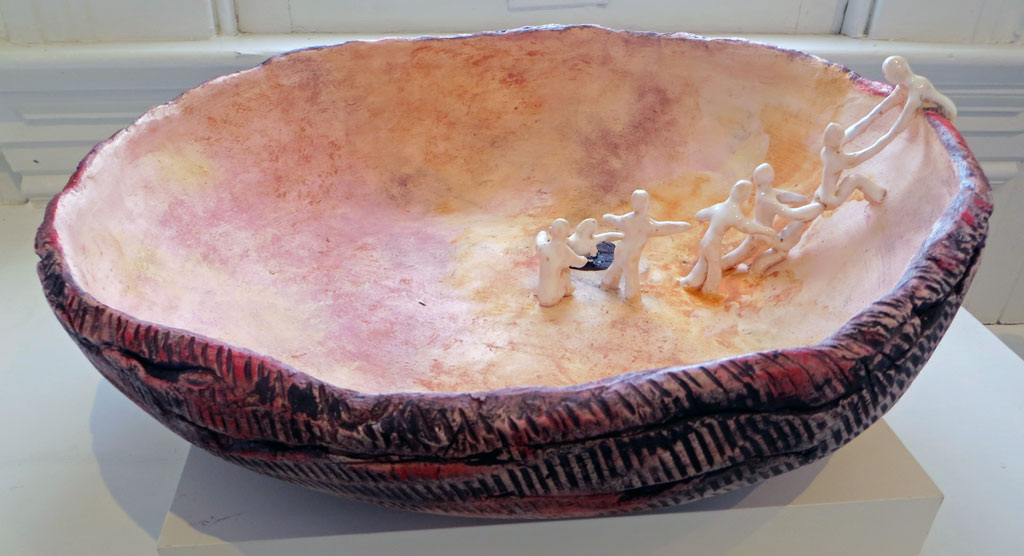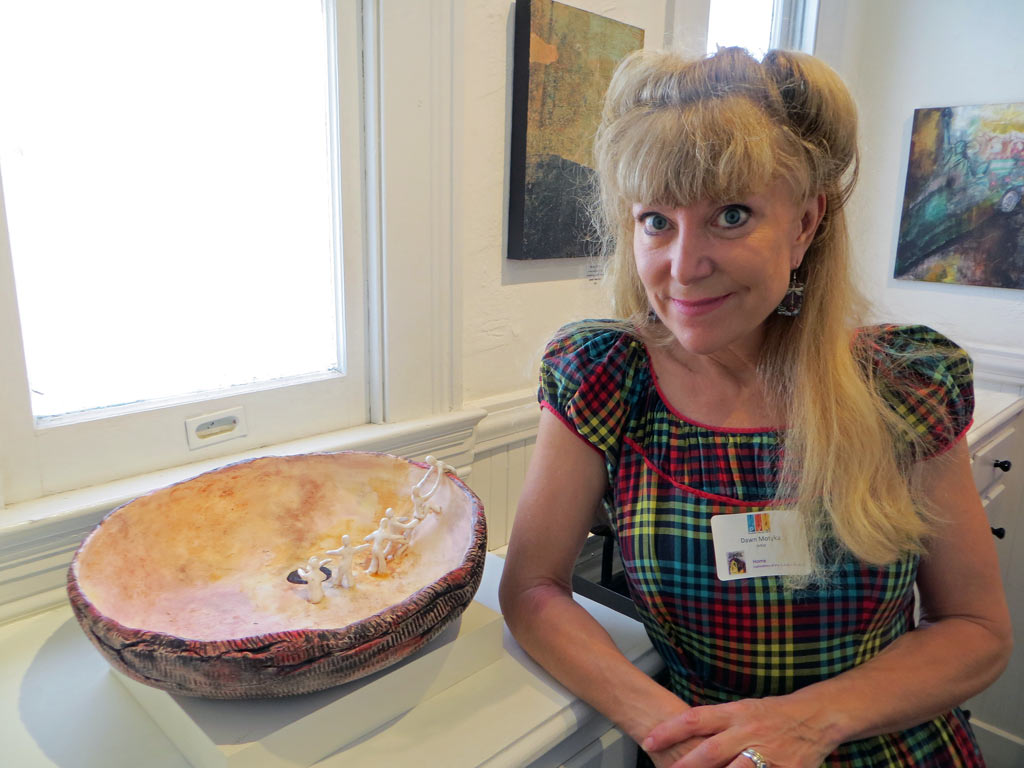
If you ask over 80 artists to create art around the theme of “HOME,” especially if you incite them to go long by suggesting “HOME can be a source of identity, a state of being, a repose of security, a place to belong, a war zone, an inalienable right,” you’re bound to see an intimately idiosyncratic array of responses. And that is most certainly true at the current home-themed exhibit at the Pajaro Valley Arts Gallery.
This is my third essay about this show (links to the others at the bottom) and the first in which I explore one of the three works from it that niggled my curiosity. When I say niggled, I mean bothered in the sense that the late Mary Warshaw – rest her wonderful beaming soul! – used it as she wryly exclaimed when something was going differently than intended in a mixed media class we were both taking, “Art bothers me!”
And being bothered is not necessarily all bad.
I went to the HOME exhibit the day it opened hoping to encounter at least a few pieces that bothered me. That raised more questions about home than they answered. Or answered them in unexpected ways. Dawn Motyka’s Sipa Pu: Hopi Creation Myth was the first piece that stopped me dead with that sort of wonderment.
When you meet evocative art and it mystifies you, a way in is to factually describe what you see, like an archeologist:
A large low and wide gently curved ceramic bowl, about 15″ across and 5″ deep, perhaps coil built, roughly textured and stained with black and red on the exterior to suggest a basket. The smoothed interior is finished in a mottled combination of warm peach, apricot and pink cloud-like colors. Off-center, but still on the bottom of the basket-bowl, is painted a small black circle. The upper half of a small white stick figure seems to be emerging from the black circle. This figure is one end of a line of seven more whole figures, also white, who, in various stretching, pushing and pulling poses create a chain which moves up and over the side of the vessel.
Next, take note of the questions which arise: Who are those people? Are they escaping? Why? Where is the HOME here? What is this about? Wait, what’s the title of this piece? Oh, the basket makes sense now, and so do its simple figures. I wish I knew more about the Hopi Creation Myth.
For answers and insight I was hoping our artist would be at the reception and I could pose my questions to her in person, instead of just wiki-ing it. She was there and happy to tell her story.

As she kindly described the meaning in her piece, a clutch of curious others gathered around us. There are many versions of this originally-oral tale of how the Hopi people came to this world – often called the Fourth World – and most of them tell of a lower level that the people crawl up and out of through a hole called the sipapu. Dawn wanted to envelop that emergence story in a lyrical basket, honoring another important aspect of Hopi culture.
The neat thing about hearing an artist describe their work and their reasons for making it is that one can begin to feel their fascination, their original impulse. What strikes me is this ceramic basket is not so much a noun as a verb: we are seeing the transformation of a people. It’s not about a personal home or even a sense of place, but about a broader cultural world: the home of the home, the ur-home. The white stick people are primal, symbolic, even iconic, but full of expression in their gestures. Dawn mentioned more than once how they are working together, helping each other, expressing their community even in transition.
I think that’s what drew me to this piece so strongly even if I couldn’t read it clearly: it explores the mystery of how it all began in this world for the Hopi – a mystery every culture throughout history has attempted to explain. And it does so not in a straightforward illustration but as a gentle and loving reveal, asking only for the viewer’s witnessing.
–Liz Crain, who also told Dawn how deeply she has enjoyed seeing her artworks over the years as they infallibly have significant, often profound, meanings. She recommends not waiting any longer to tell an artist you know how and why their work moves you.
Links for Posts About the HOME Exhibit and My Piece in It
“Homefire 1957” Sculpture
- Between Two Fires – An overview of the finished work, including photos of it.
- R&D for Homefire 1957 – A look at the information and image-gathering that went into this piece.
- The Soviets Thumb Their Collective Nose – A description of the imagery and meaning on the back side
“HOME” Exhibit
- Bringing it All Home – Delivering the piece to the exhibit.
- In Which I Find My Art Reception Mojo – Some tips on feeling at home at art receptions
Exhibit Details: “HOME” Member’s Exhibit 2016, July 6 – August 7, 2016, Pajaro Valley Arts Gallery, 37 Sudden St., Watsonville, CA